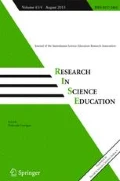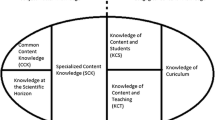Abstract
Physics continues to be widely regarded by students as difficult and therefore unattractive. Electricity is a particular problem, as it involves extremely complex and highly abstract concepts and is thus totally dependent on models/analogies/metaphors. Research consistently shows very poor student understanding after the teaching of electricity. We consider this research and draw two broad conclusions of central relevance to the teaching of electricity (which are both also argued to be significant contributors to student learning difficulties): there is an absence of any systemic consensus about what models etc. are appropriate for students at different year levels and for different intended learning outcomes; there is no consensus about appropriate learning outcomes for electricity at different levels.
Similar content being viewed by others
References
Ameh, C., & Gunstone, R. (1985). Teachers' concepts in science. Research in Science Education, 15, 151-157.
Andersson, B., & Karrqvist, C. (1979). Electric circuits (EKNA Report No. 2). Sweden: University of Gothenburg.
Arons, A. (1995). Generalisations for research on teaching and learning. In C. Bernardini, C. Tarsitani, & M. Vicentini (Eds.), Thinking physics for teaching (pp. 1-7). New York: Plenum Press.
Borges, A., & Gilbert, J. (1999). Mental models of electricity. International Journal of Science Education, 21, 95-117.
Cohen, R., Eylon, B.-S., & Ganiel, U. (1983). Potential difference and current in simple electric circuits: A study of students' concepts. American Journal of Physics, 51, 407-412.
Cosgrove, M. (1995). A study of science-in-the-making as students generate their own analogy for electricity. International Journal of Science Education, 17, 295-310.
Cosgrove, M., Osborne, R., & Carr, M. (1985). Children's intuitive ideas on electric current and the modification of those ideas. In R. Duit, W. Jung, & C. von Rhöneck (Eds.), Aspects of understanding electricity (pp. 247-256). Kiel, Germany: Schmidt, & Klaunig.
Dagher, Z. (1997). The case for analogies in teaching science for understanding. InJ. Mintzes, J. Wandersee, & J. Novak (Eds.), Teaching science for understanding (pp. 195-211). San Diego: Academic Press.
Driver, R., & Oldham, V. (1986). A constructivist approach to curriculum development. Studies in Science Education, 13, 105-122.
Duit, R. (1991). On the role of analogies and metaphors in learning science. Science Education, 75, 649-672.
Duit, R., Goldberg, F., & Niedderer, H. (Eds.). (1992). Research in physics learning: Theoretical issues and classroom studies. Kiel, Germany: IPN.
Duit, R., Jung, W., & von Rhöneck, C. (1985). Aspects of understanding electricity. Kiel, Germany: Schmidt, & Klaunig.
Dupin, J.-J., & Joshua, S. (1987). Conceptions of French pupils concerning electric circuits: Structure and evolution. Journal of Research in Science Teaching, 24, 791-806.
Eylon, B.-S., & Ganiel, U. (1990). Macro-micro relationships: The missing link between electrostatics and electrodynamics in student reasoning. International Journal of Science Education, 12, 79-94.
Fensham, P. (1999, Sept.). Science content as problematic: Issues for research.Invited paper given at the Second International Conference of the European Science Education Research Conference, Kiel, Germany.
Fensham, P., Gunstone, R., & White, R. (Eds.). (1994). The content of science. London: Falmer.
Fredette, N., & Lochhead, J. (1980). Student conceptions of simple circuits. The Physics Teacher, 18, 194-198.
Fuller, R., Brownlee, R., & Baker, D. (1937). First principles of physics. NewYork: Norwood Press.
Gauld, C. (1986). Models, meters and memory. Research in Science Education, 16, 49-54.
Gunstone, R. (2000). Constructivism in the classroom. In D. Philips (Ed.), Constructivism in education: Opinions and second opinions on controversial issues (pp. 254-280). Chicago: University of Chicago Press.
Heilbron, J. (1979). Electricity in the 17th and 18th centuries: A study of early modern physics. Berkeley, CA: University of California Press.
Heller, P., & Finley, F. (1992). Variable uses of alternative conceptions: A case-study in electricity. Journal of Research in Science Teaching, 29, 259-275.
Hopmann, S., & Riquarts, K. (Eds.). (1995). Didaktik and/or curriculum. Kiel, Germany: IPN.
Klein, M. (1972). The use and abuse of historical teaching in physics. In S. Brush, & A. King (Eds.), History in the teaching of physics (pp. 12-18). Hanover, NH: University Press of New England.
Loughran, J. J., Gunstone, R. F., Berry, A., Milroy, P., & Mulhall, P. (2000, April). Science Cases in Action: Developing an understanding of science teachers' pedagogical content knowledge. Paper presented at the Annual Meeting of the National Association for Research in Science Teaching, New Orleans.
McDermott, L., & Shaffer, P. (1993). Research as a guide for curriculum development: An example from introductory electricity. Part I: Investigation of student understanding. American Journal of Physics, 60, 994-1003 (erratum 61, 81).
Mulhall, P., Milroy, P., Berry, A., Gunstone, R., & Loughran, J. (2000, June). Enhancing understanding of science pedagogical content knowledge for teachers and researchers. Paper presented at the conference of the Australasian Science Education Research Association, Fremantle.
Niedderer, H. (1999, Sept.). Personal communication, Kiel.
Niedderer, H., & Goldberg, F. (1994, April). An individual student's learning process in electric circuits. Paper presented at the annual meeting of the National Association for Research in Science Teaching, Anaheim, CA.
Osborne, R. (1983). Modifying children's ideas about electricity current. Research in Science and Technological Education, 1, 73-82.
Osborne, R., & Freyberg, P. (Eds.). (1985). Learning in science: The implications of children's science. Auckland: Heinemann.
Peters, P. (1982). Even honors students have conceptual difficulties with physics. American Journal of Physics, 50, 501-508.
Pfundt, H., & Duit, R. (1994). Bibliography–Students' alternative frameworks and science education (4th ed.). Kiel, Germany: IPN.
Psillos, D. (1997). Teaching introductory electricity. In A. Tiberghien, E. L. Jossem, & J. Barojas (Eds.), Connecting research in physics education with teacher education. International Commission on Physics Education. Published electronically at URL http://www.physics.ohio-state.edu/jossem/ICPE/BOOKS.html
Psillos, D., Koumaras, P., & Tiberghien, A. (1988). Voltage presented as a primary concept in an introductory teaching sequence on DC circuits. International Journal of Science Education, 10, 29-43.
Shaffer, P., & McDermott, L. (1992). Research as a guide for curriculum development: An example from current electricity. Part II: Design of instructional strategies. American Journal of Physics, 60, 1003-1013.
Shepardson, D., & Moje, E. (1999). The role of anomalous data in restructuring fourth graders' frameworks for understanding electric circuits. International Journal of Science Education, 21, 77-94.
Shipstone, D. (1984). A study of children's understanding of electricity in simple DC circuits. European Journal of Science Education, 6, 185-188.
Shipstone, D., & Gunstone, R. (1985). Teaching children to discriminate between current and energy. In R. Duit, W. Jung, & C. von Rhöneck (Eds.), Aspects of understanding electricity (pp. 287-297). Kiel, Germany: IPN.
Stocklmayer, S., & Treagust, D. (1996). Images of electricity: How do novices and experts model electric current? International Journal of Science Education, 18, 163-178.
Schwedes, H., & Dudeck, W.-G. (1996). Teaching electricity by help of a water analogy (how to cope with the need for conceptual change). In Research in science education in Europe (pp. 50-63). London: Falmer.
Tabanera, M. (1995). The impact of tertiary teachers' understanding of electricity on their teaching. Unpublished PhD thesis, Monash University, Melbourne, Australia.
Treagust, D., Duit, R., & Fraser, B. (Eds.). (1996). Improving teaching and learning in science and mathematics. New York: Teachers College Press.
Treagust, D., Duit, R., Joslin, P., & Lindauer, I. (1992). Science teachers' use of analogies: Observations from classroom practice. International Journal of Science Education, 14, 413-422.
Viennot, L. (1993). Fundamental patterns in common reasoning: examples in Physics. In P. Linjse (Ed.), European research in science education (pp. 33-47). Den Haag, Netherlands: Gegevens Koninkluke Bibliotheek.
Viennot, L., & Rainson, S. (1992). Students' reasoning about the superposition of electric fields. International Journal of Science Education, 14, 475-487.
von Rhöneck, C., Grob, K., Schnaitmann, G., & Völker, B. (1998). Learning in basic electricity: How do motivation, cognitive and classroom climate factors influence achievement in physics? International Journal of Science Education, 20, 551-565.
Author information
Authors and Affiliations
Rights and permissions
About this article
Cite this article
Mulhall, P., McKittrick, B. & Gunstone, R. A Perspective on the Resolution of Confusions in the Teaching of Electricity. Research in Science Education 31, 575–587 (2001). https://doi.org/10.1023/A:1013154125379
Issue Date:
DOI: https://doi.org/10.1023/A:1013154125379




